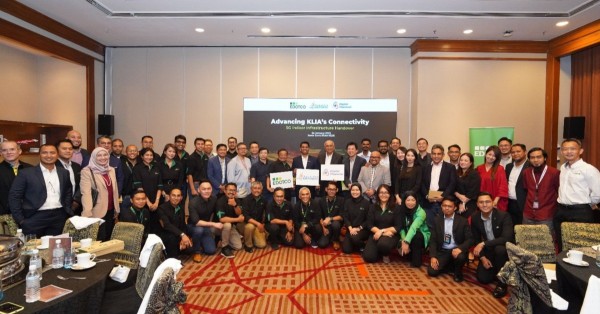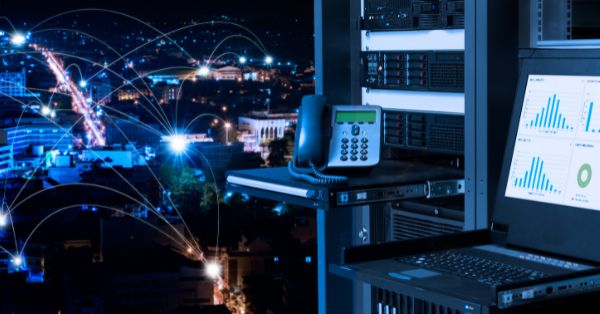Malaysia is strengthening its position as a digital hub by enhancing connectivity at key transportation hubs. Digital Nasional Berhad (DNB) and EDOTCO Group have completed the installation of 5G In-Building Solutions (IBS) at Kuala Lumpur International Airport (KLIA) and KLIA2. This upgrade is part of a broader effort to enhance the passenger experience, improve airport operations, and align with Malaysia’s ASEAN Chairmanship goals.
Overcoming 5G Connectivity Challenges at KLIA & KLIA2
Airports are high-density environments where seamless connectivity is essential for passengers, businesses, and operational teams. Key challenges included:
- Signal congestion due to thousands of simultaneous users.
- Limited indoor coverage impacting connectivity in terminals.
- Need for higher speeds to support IoT, smart sensors, and digital services.
- Efficient network deployment without disrupting airport operations.
Solution: Deployment of 5G In-Building Solutions (IBS)
DNB and EDOTCO tackled these challenges by installing 5G IBS across KLIA and KLIA2, ensuring high-speed, low-latency connectivity for passengers, staff, and businesses.
- Fast Deployment: The installation was completed in just two months.
- Seamless Handover: The system was activated at a ceremony with DNB, EDOTCO, and Malaysia Airports Holdings Berhad.
- Extensive Coverage: The project complements existing 5G outdoor sites that cover 82% of populated areas in Malaysia.
Where 5G IBS is Already Powering Connectivity in Malaysia
DNB has already implemented 5G IBS at 73 strategic sites, including:
- Airports: Senai International, Penang International.
- Transportation Hubs: KL Sentral.
- Healthcare Facilities: Institut Jantung Negara (IJN), Hospital Putrajaya, Hospital Selayang.
- Government Buildings: Various Urban Transformation Centres (UTCs).
Why 5G IBS is the Best Choice for Airport Connectivity
5G IBS improves connectivity and network efficiency in enclosed spaces. It enables:
- Higher speeds and capacity: Supports high-density areas like airport terminals.
- Reliable connectivity: Ensures low latency for real-time applications.
- Support for emerging use cases: Enables IoT, automation, and digital transformation.
Key Benefits of 5G IBS for KLIA & KLIA2 Passengers and Businesses
- Improved Passenger Experience: Faster mobile data speeds for seamless streaming, communication, and navigation.
- Enhanced Airport Operations: Supports smart sensors, automated logistics, and AI-powered security.
- New Business Opportunities: Enables digital retail, augmented reality (AR) services, and innovative passenger solutions.
- Sustainability: Reduces energy consumption with efficient network infrastructure.
How 5G is Turning KLIA & KLIA2 into Smart Airports
With 5G connectivity, KLIA and KLIA2 are evolving into smart airports, leveraging:
- Autonomous Vehicles: eMooVit’s 5G-powered autonomous buggies for passenger transport.
- Last-Mile Delivery Robots: CelcomDigi’s 5G-AI-powered robots for luggage and package transport.
- Contactless Operations: AI-driven check-ins, automated baggage handling, and real-time tracking.
DNB’s Vision for Expanding 5G Nationwide
DNB is leading Malaysia’s national 5G rollout, focusing on:
- Expanding 5G Private Networks in commercial and strategic buildings.
- Collaborating with Mobile Network Operators (MNOs) to enhance indoor coverage.
- Enabling digital transformation in airports, hospitals, and urban centers.
EDOTCO’s Contribution to Malaysia’s 5G Infrastructure
As Malaysia Airports’ preferred partner, EDOTCO has:
- Delivered 52 5G IBS solutions across KLIA and KLIA2.
- Installed 9 outdoor 5G poles within a 10km x 10km KLIA radius.
- Expanded its tower infrastructure portfolio across Asia, supporting sustainable connectivity.
What’s Next for 5G at KLIA, KLIA2 & Beyond?
The KLIA 5G IBS system is now fully operational. Future expansions include:
- Extending 5G IBS to more airports, commercial buildings, and government facilities.
- Enhancing smart airport solutions with AI-driven automation.
- Strengthening Malaysia’s position as an ASEAN digital leader.
What Industry Leaders Say About 5G at KLIA & KLIA2
DNB CEO, Datuk Azman Ismail“DNB’s focus is to enhance 5G indoor coverage and connectivity in key locations, ensuring seamless digital experiences for all Malaysians.”
EDOTCO CEO, Adlan Tajudin “Our commitment to innovative, sustainable infrastructure supports Malaysia’s digital aspirations and economic growth.”
Malaysia Airports CIO, VijayKumar Dayinde “The integration of 5G at KLIA is a transformative step towards a more efficient, connected, and passenger-friendly airport experience.”
DNB and EDOTCO’s successful 5G IBS deployment at KLIA and KLIA2 marks a major milestone in Malaysia’s digital transformation. With 5G, airports are becoming smarter, more efficient, and future-ready, enhancing both passenger experiences and operational efficiency. As Malaysia assumes the ASEAN Chairmanship in 2025, this initiative further cements its role as a regional digital hub. For more information: DNB: www.digital-nasional.com.my and EDOTCO Group: www.EDOTCOgroup.com






















